
William Alexander Graham was a United States senator from North Carolina from 1840 to 1843, a senator later in the Confederate States Senate from 1864 to 1865, the 30th governor of North Carolina from 1845 to 1849 and U.S. secretary of the Navy from 1850 to 1852, under President Millard Fillmore. He was the Whig Party nominee for vice-president in 1852 on a ticket with General Winfield Scott.
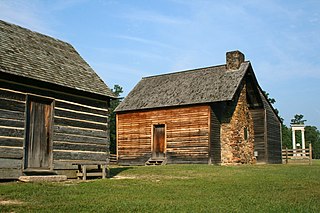
Bennett Place is a former farm and homestead in Durham, North Carolina, which was the site of the last surrender of a major Confederate army in the American Civil War, when Joseph E. Johnston surrendered to William T. Sherman. The first meeting saw Sherman agreeing to certain political demands by the Confederates, which were promptly rejected by the Union cabinet in Washington. Another meeting had to be held to agree on military terms only, in line with Robert E. Lee’s recent surrender to Ulysses S. Grant. This effectively ended the war.
The Alice Freeman Palmer Memorial Institute, better known as Palmer Memorial Institute, was a school for upper-class African Americans. It was founded in 1902 by Dr. Charlotte Hawkins Brown at Sedalia, North Carolina near Greensboro. Palmer Memorial Institute was named after Alice Freeman Palmer, former president of Wellesley College and benefactor of Dr. Brown.
Freeman House or variations such as Freeman Farm may refer to:
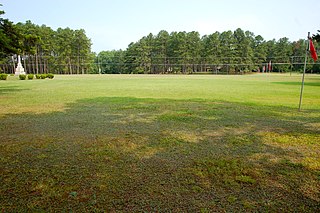
Alamance Battleground is a North Carolina State Historic Site commemorating the Battle of Alamance. The historic site is located south of Burlington, Alamance County, North Carolina in the United States.
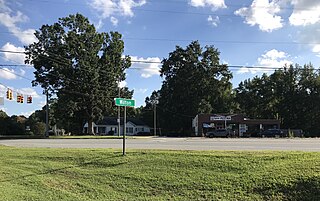
Wilton is an unincorporated community in southern Granville County, North Carolina, United States. It lies north of Grissom and is the former home of Wilton High School.

The Samuel Freeman House is a Frank Lloyd Wright house in the Hollywood Hills of Los Angeles, California built in 1923. The house was listed on the National Register of Historic Places in 1971. The house is also listed as California Historical Landmark #1011 and as Los Angeles Historic-Cultural Monument #247.

The James Iredell House is a historic home located at Edenton, Chowan County, North Carolina. The original section was built 1800, and expanded to its present configuration about 1827. It is a two-story, "L"-shaped frame dwelling with Georgian and Federal style design elements. It was the home of James Iredell, an ardent patriot and Justice of the Supreme Court.
Gates is an unincorporated community in Gates County, North Carolina, United States. Gates is located on North Carolina Highway 37, 7 miles (11 km) north of Gatesville. Gates has a post office with ZIP code 27937.

This list includes properties and districts listed on the National Register of Historic Places in Currituck County, North Carolina. Click the "Map of all coordinates" link to the right to view an online map of all properties and districts with latitude and longitude coordinates in the table below.
Charles Christian Hook (1870–1938) was an American architect. He was also the founder of FreemanWhite, Inc. a Haskell Company (1892), the oldest practicing firm in North Carolina and currently the 11th oldest architecture firm in the United States.

Halifax Historic District is a national historic district located at Halifax, Halifax County, North Carolina, US that was listed on the National Register of Historic Places in 1970. It includes several buildings that are individually listed on the National Register. Halifax was the site of the signing of the Halifax Resolves on April 12, 1776, a set of resolutions of the North Carolina Provincial Congress which led to the United States Declaration of Independence gaining the support of North Carolina's delegates to the Second Continental Congress in that year.

Warrenton is a town in, and the county seat of, Warren County, North Carolina, United States. The population was 862 at the 2010 census. Warrenton, now served by U.S. routes 158 and 401, was founded in 1779. It became one of the wealthiest towns in the state from 1840 to 1860, being a trading center of an area of rich tobacco and cotton plantations. It has a large stock of historic architecture buildings. More than 90 percent of its buildings are listed in the National Register of Historic Places and its National Historic District encompasses nearly half its area.
King-Freeman-Speight House, also known as Francis Speight House, is a historic plantation house located at Republican, Bertie County, North Carolina. It was built in two sections, with the oldest built between 1808 and 1828. The older section forms the basis of the current rear wing. About 1828, a 2+1⁄2-story, Federal style, side-hall plan was added at a right angle to the original structure. The house was enlarged and remodeled in 1907. It has a two-story, two-bay addition and a two-story rear addition built in 1855. It features a hip roof front porch. Also on the property are the contributing two smokehouses, the kitchen, and an office. Noted landscape artist Francis Speight was born in the house in 1896.
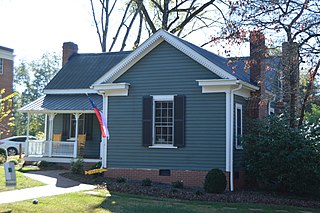
Lewis Freeman House is a historic home located at Pittsboro, Chatham County, North Carolina. The original section was built between about 1811 and 1837, and expanded through the 1890s. It is a one-story, three bay frame cottage with Queen Anne style design elements. The original one-room structure represents the modest home of Lewis Freeman, a free black settler in Pittsboro. The home is one of four remaining dwellings from the town's initial settlement. Due to the lack of records during the early 1800s, little is known about the first residents of the area.
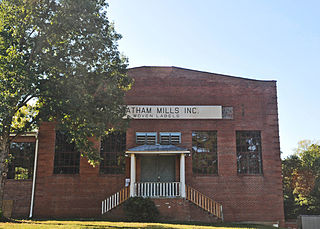
Pittsboro Historic District is a national historic district located at Pittsboro, Chatham County, North Carolina. The district encompasses 131 contributing buildings, 3 contributing sites, and 1 contributing object in the county seat of Pittsboro. Located in the district and separately listed are the Chatham County Courthouse, the Hall-London House, the Moore-Manning House, the Reid House, the Lewis Freeman House, the McClenahan House, and the Patrick St. Lawrence House. Other notable buildings include the Blair Hotel, Pilkington Drug Store / S & T' s Soda Shoppe, Justice Motor Company building (1949), St. Bartholomew's Episcopal Church (1832), Pittsboro United Methodist Church, and Queen Anne style Henry H. Fike House.

Joseph Freeman Farm is a historic farm complex and national historic district located near Gates, Gates County, North Carolina. The district encompasses six contributing buildings, one contributing site, and three contributing structures. The main house was built about 1821, and is a two-story, two-bay dwelling in a transitional Georgian / Federal style. A separate two-room kitchen/dining room ell was added about 1915. Associated with the house are the contributing smokehouse, privy, pump house, and domestic well. Contributing farm outbuildings include the lot well, equipment shelter, feed and livestock barn, and slave / tenant house.

Freeman House, also known as The Stateline House, is a historic home located on the North Carolina-Virginia state line near Gates, Gates County, North Carolina, USA. The house was built in three building phases, the earliest perhaps dating to the late-18th century. The farmhouse was initially built following the basic early-Federal-style one-room plan, followed by the addition of a late-Federal-style two-story side-hall-plan, which was finally enlarged and converted in the mid-19th century to a more substantial Greek Revival style, center-hall-plan dwelling. The main section is a two-story, five bay, frame structure. Also on the property are the contributing smokehouse, a kitchen with exterior end chimney, a one-story tack house with an attached wood shed, a small, unidentified shed, two large barns, and a stable.

Freeman House, also known as The Hertford Academy, is a historic school building located in the Murfreesboro Historic District at Murfreesboro, Hertford County, North Carolina. It was built about 1810, and is a two-story, Federal style brick building with a hip roof and central passage plan. It is considered the birthplace of Chowan University.

















